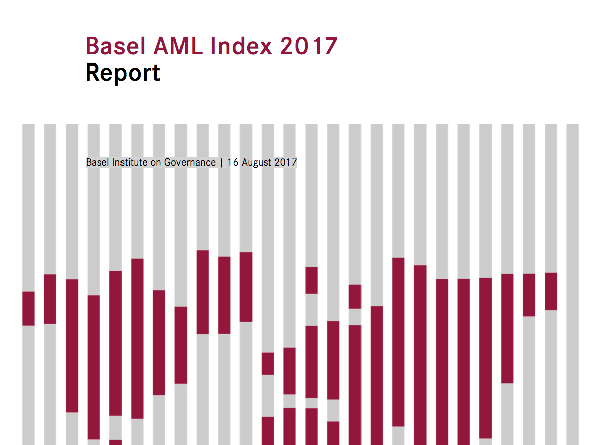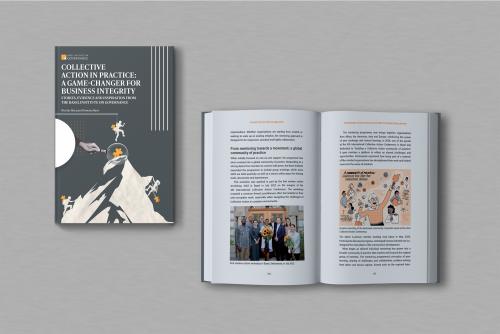Launch of the Basel Anti-Money Laundering Index 2017

The Basel Institute on Governance has just released its sixth edition of the Basel Anti-Money Laundering (AML) Index, an annual ranking assessing 146 countries regarding money laundering/terrorism financing risks. To date it remains the only research-based risk rating of countries in this field issued by an independent non-profit institution. It is used by the private sector as an established AML country risk-rating tool for compliance purposes, and in the public sector for research and policy measurement.
Since its first release in 2012 the Index has not seen significant changes in terms of countries occupying the top ten risk positions; yet, in the 2017 Basel AML Index we observe that the average country risk level has been deteriorating at least during the last three years. While the global average risk scores were 5.82 in 2015 and 5.85 in 2016, the average risk score this year is equal to 6.15 (on a scale of 0=low risk to 10=high risk).
Main results and findings in 2017
- The 10 countries with the highest AML risk are Iran, Afghanistan, Guinea-Bissau, Tajikistan, Laos, Mozambique, Mali, Uganda, Cambodia and Tanzania.
- The three lowest risk countries are the same as last year: Finland, followed by Lithuania and Estonia.
- The greatest improvements since 2016 have been made by Sudan, Taiwan (China), Israel and Bangladesh.
- The countries that deteriorated most severely in their scores in 2017 are Jamaica, Tunisia, Hungary, Uzbekistan and Peru.
Although a majority of countries legally comply with current AML/countering terrorism financing (CTF) standards, most continue to fall (sometimes severely short) in terms of effective implementation and enforcement of these laws. By including data from the FATF, which for the past few years has used an assessment methodology that looks not only at technical compliance but also at enforcement capacity, the Basel AML Index is increasingly able to capture this significant difference.
Regional findings and highlights
East Asia and Pacific
In East Asia and the Pacific, Laos, Cambodia, Myanmar, Vietnam, Marshall Islands are the top risk countries in the region. Taiwan (China) has recorded the largest improvements, whereas Laos’ ranking deteriorated the most.
Eurasia
Tajikistan, Turkey, Ukraine, Kazakhstan and Kyrgyzstan are the top risk countries in the region. Uzbekistan has recorded the largest deterioration in the region.
EU
In the EU the highest risk countries are Hungary, Italy, Luxembourg, Greece and Austria. Germany and France improved their positions. Hungary demonstrated the worst deterioration in the region this year.
Latin America & Caribbean
In Latin America and the Caribbean region, Paraguay, Haiti, Bolivia, Panama, Trinidad and Tobago, and Argentina are considered to be the highest risk countries. Peru, Ecuador and Trinidad and Tobago have recorded the most severe deterioration in the region.
Middle East and North Africa (MENA)
Iran, Lebanon, Yemen, Algeria, and Morocco are considered to be the highest risk countries within the MENA region according to this year’s Basel AML Index. Egypt has recorded the most significant deterioration in the region.
North America
The US has switched positions with Canada and is now considered lower risk as compared with last year’s ranking.
South Asia
Among the six South Asian countries, Afghanistan, Nepal and Sri Lanka stand out with particular high-risk scores in the Basel AML Index.
Sub-Saharan Africa
The Sub-Saharan Africa region has the poorest scores worldwide with Guinea-Bissau, Mozambique, Mali, Uganda, and Tanzania among the top 5 highest risk countries in the region.
More information about the Basel AML Index along with graphics and excel data file will be available on August 16, 2017 at: index.baselgovernance.org
About the Basel AML Index
The current Basel AML Index edition covers 146 countries and assigns each country a score on a scale from 0 (low risk) to 10 (high risk). High-risk scores in the Basel AML Index generally indicate weak AML/CTF standards, low institutional capacities and a lack of transparency in the financial and public sector.
The Basel AML Index does not assess the amount of illicit financial money or transactions but is designed to assess the risk of money laundering, i.e. to indicate the vulnerability of a country to money laundering and terrorism financing based on publicly available indicators.
The Basel AML Index is a composite index, meaning the overall score is a weighted average of 14 indicators from various publicly available sources such as the Financial Action Task Force (FATF), Transparency International, the World Bank and the World Economic Forum.


